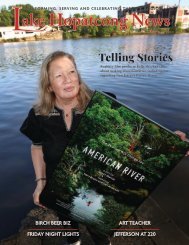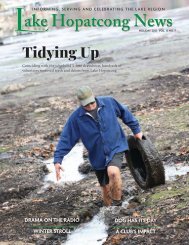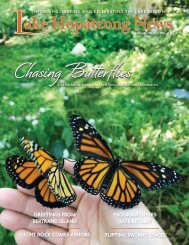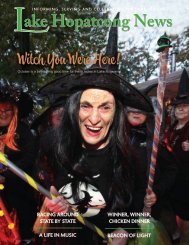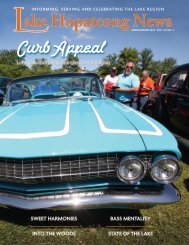You also want an ePaper? Increase the reach of your titles
YUMPU automatically turns print PDFs into web optimized ePapers that Google loves.
WORDS OF<br />
A FEATHER<br />
Scan the QR code<br />
with your phone’s<br />
camera to hear a<br />
muskrat.<br />
Muskrat Love<br />
Summer is in<br />
full swing on<br />
Lake Hopatcong.<br />
And nothing feels<br />
better than the<br />
long, languid, sunny days.<br />
Boats of every type jauntily cruise along,<br />
and the water has warmed up enough to make<br />
swimming a delicious pleasure. Slipping into<br />
the lake, particularly after a long day trapped<br />
indoors at work, feels like bliss.<br />
On days like this, you seem to gain sustenance<br />
from the water and never want to stray from<br />
the lake.<br />
If you can relate to any of that, you may not<br />
know it but you have quite a bit in common<br />
with some of the lake’s furrier swimmers:<br />
muskrats.<br />
When I lived at Lake Hopatcong in Mount<br />
Arlington, I’d often see them swimming around<br />
docks, either in the early mornings or evenings.<br />
They’d glide along with most of the top half<br />
of their bodies visible above the waterline,<br />
always silent but giving the impression of being<br />
constantly busy. They plied the water, it seemed<br />
to me, with purpose.<br />
I got curious about them, so I decided to<br />
focus this month’s column on these small<br />
mammals. Turns out they’re pretty fascinating.<br />
Who knew?<br />
Native to North America and found across<br />
most of the continent—from the Arctic to the<br />
south (but not in Florida where I reside!)—<br />
muskrats are large rodents. Surprisingly, they<br />
are more closely related to voles, lemmings and<br />
mice than to that other semi-aquatic mammal,<br />
the beaver.<br />
Muskrats have quite a round shape, with tiny<br />
ears, short Tyrannosaurus rex-like forelimbs<br />
and a continually active, quivering nose.<br />
Their dark brown fur is dense and luxurious.<br />
Consequently and unfortunately, they are still<br />
killed for their pelts—usually in cruel traps that<br />
drown them.<br />
Fur is not a fabric, and compassion is in<br />
fashion, folks. Remember, fur only looks good<br />
on animals, not on people.<br />
38<br />
by HEATHER SHIRLEY<br />
Photo by KAREN FUCITO<br />
LAKE HOPATCONG NEWS <strong>Midsummer</strong> <strong>2022</strong><br />
A muskrat scampers along the dock<br />
at Lee’s County Park Marina.<br />
Muskrat fur traps air, which both warms<br />
them through frigid winters and helps them<br />
float.<br />
Muskrats range in size from 16 to 25 inches<br />
long, including their odd tails. Used like a<br />
rudder when swimming, their 7- to 11-inchlong<br />
tail is vertically flattened and is covered in<br />
scales.<br />
Their hind legs are also unique. Their feet<br />
are not webbed, as I would have expected since<br />
otter and beaver feet are webbed. Instead, a<br />
muskrat foot looks a bit like a tiny hand, with<br />
each toe edged with a fringe of stiff hair that<br />
helps the foot function like a paddle.<br />
Muskrats swim with their feet much like<br />
we do, alternating kicks from their left and<br />
right legs. They can swim both forward and<br />
backward, as fast as 3 mph, and can hold their<br />
breath for up to 17 minutes.<br />
Not impressed yet? Keep reading—muskrats<br />
and their marvelous adaptations may still<br />
surprise you.<br />
Muskrats are quite social, living in large,<br />
territorial family groups. They communicate by<br />
marking entrances to lodges with a strong scent<br />
secreted from specialized glands. It is for this<br />
scent, or musk, that they are named.<br />
They must live near water of at least 4 to 6<br />
feet in depth and either excavate burrows along<br />
the banks or construct lodges, also called “pushups,”<br />
in the water. Made from mud and aquatic<br />
vegetation like cattails, these constructions are<br />
used by other animals and birds as spots to rest<br />
and/or nest.<br />
Because bits of their watery homes can float<br />
Call Jim to buy or list today!<br />
House Values<br />
James J. Leffler<br />
Realtor<br />
RE/MAX House Values<br />
131 Landing Road<br />
Landing, NJ 07850<br />
201-919-5414 Cell<br />
973-770-7777 Office<br />
jimleff.rmx@gmail.com<br />
away or be eaten by the muskrats themselves,<br />
they are constantly rebuilding, thus consuming<br />
more lake-clogging vegetation. They are<br />
voracious feeders, eating one-third of their<br />
body weight in vegetation each day. In this way,<br />
muskrats help keep waterways clear, providing<br />
ducks and other birds with open space to float<br />
and feed. All that foraging results in underwater<br />
trails that the muskrats travel daily, searching<br />
for food and rarely straying more than 150 feet<br />
from their home.<br />
They know their territory so well that they’re<br />
able to find food every day, year-round, even<br />
under ice and snow, and even in the dark.<br />
Yet another adaptation of muskrats is a<br />
mechanism known as regional heterothermia.<br />
This system regulates blood flow to the<br />
muskrat’s feet and tail so that those areas are<br />
cooler than their core, thus helping the animals<br />
maintain body heat in cold water.<br />
Muskrats have even evolved to be able to bite<br />
and chew underwater; their incisor teeth stick<br />
out from the rest of their mouths, and their<br />
lips and cheeks can close behind the teeth. In<br />
this way, they don’t take in water as they nibble<br />
roots and stems.<br />
In addition to plants, muskrats eat just about<br />
anything, including fish, snails, crustaceans,<br />
salamanders and mollusks. In turn, they<br />
are heavily preyed by a vast range of species,<br />
including coyotes, bears, snapping turtles and<br />
even pike.<br />
But, like most rodents, they reproduce<br />
frequently, producing up to three litters per<br />
year of three to eight kits each. That means your<br />
chances of seeing a muskrat are pretty good.<br />
I hope the next time you see one near your<br />
dock, you have a newfound respect for them<br />
and that you show that muskrat some love.<br />
James J. Leffler<br />
Realtor



